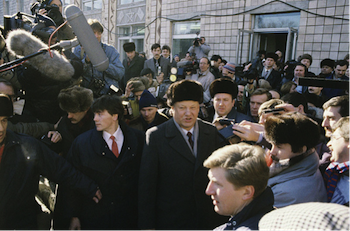

|
Nationalism in the Soviet Union  Yeltsin campaigning in the March 1991 referendum on the future of the Union The East European revolutions added fuel to nationalist movements in the Soviet Union. The three Baltic countries were the first to call for independence, followed by the Georgians and Armenians and much of Ukraine and Moldova. Gorbachev's reforms facilitated nationalist movements. The establishment of a Soviet Presidency encouraged republican leaders to copy the idea. Yeltsin's election as the Russian President in June 1991 was especially important, as it gave him more authority than the unelected Soviet President and enabled him to build up Russia as independent state and undermine the Soviet Union. The introduction of contested elections for the Supreme Soviet in each republic allowed nationalists to win control of them and declare independence from Moscow. In the three Baltic states, nationalists swept to victory in the 1990 elections. Police repression of nationalist demonstrations also fuelled the independence movements in Georgia and the Baltic states. In Tbilisi 19 demonstrators were killed and several hundred wounded by the Soviet police in April 1989. In Lithuania and Latvia the Soviet crackdown killed 17 in January 1991. The Baltic repressions were the initiative of Communist hardliners hoping to provoke a violent response by the nationalists which could be used by Moscow to justify the introduction of a state of emergency. Hardliners in the KGB and the military were organizing against Gorbachev reform's to prevent the break-up of the Soviet Union. The key battleground was Gorbachev's initiative to hold a referendum in each Soviet republic on a new union treaty and to negotiate its form with the republican leaders. He wanted to agree a federal structure that would keep the Soviet Union together but accepted it was wrong to keep it united by force. Like Lenin, he thought it could survive as a voluntary union. Six republics were determined to break away from the Soviet Union and refused to hold a referendum (Georgia, Armenia, Moldavia and the three Baltic states). But in the nine other republics 76 per cent of the population voted for maintaining the federal system of the Soviet Union in a referendum on 17 March 1991. A draft treaty was negotiated between the Soviet central government and the nine republican leaders (the '9+1' agreement) and signed on 23 April at Novo-Ogarevo near Moscow. By August, eight of the nine republics had approved the draft treaty. |
© 2014 Orlando Figes | All Rights Reserved